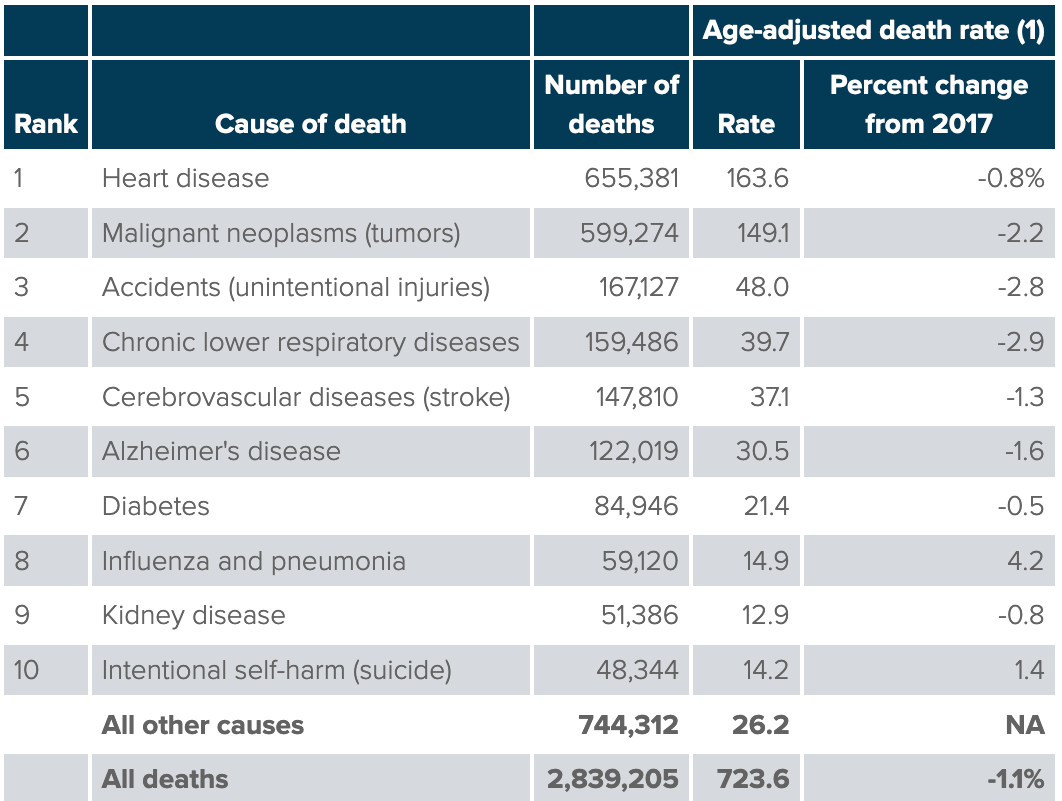COVID-19 Adds to 'Normal' Death Toll from Disease, Drugs, Guns, Cars

There are many ways to die but they basically boil down to accidental and natural, with the coronavirus pandemic expected to increase deaths in several categories this year thanks to the social and economic dislocations brought on by the pandemic.
Heart disease and cancer are the leading causes of “natural” death in the U.S. most years, with poisoning, guns and car crashes the leading forms of accidental deaths, recent research from the Insurance Information Institute shows.
Heart disease (655,000 deaths) and cancer (599,000) in 2018 – the last year for which complete statistics have been compiled – are clear leaders in “natural” deaths with all forms of accidental deaths totaling 167,000.
This chart shows the ten leading causes of deaths in 2018, the last year for which complete figures are available:

COVID-19 will skew the figures for 2020 and, sadly, 2021 as well. By the end of 2020, the number of COVID-19 deaths in the United States was already larger than the number of U.S. combat deaths during World War II. By early January 2021, there had been 20 million cases in the U.S., and 350,000 deaths.
Opioids blamed
Researchers say the pandemic and the opioid crisis are combining to make matters worse.
“The pandemic compounded an existing crisis – the opioid epidemic – with high unemployment rates, social isolation, and despair, all known risk factors for substance use,” says Sara Whaley, MPH, MSW, research associate in Johns Hopkins University’s Bloomberg School’s Department of Health Policy and Management. “We have to support treatment providers, health departments, and other services that support people with substance use disorder, so they can provide essential, lifesaving services to those most in need.”
Whaley is the lead author of a Bloomberg report, Saving Lives from Overdose During a Pandemic, that calls for state and local jurisdictions to declare syringe service programs to be essential services during the pandemic.
Many of these programs have been disrupted due to pandemic mitigation efforts, leaving clients with fewer resources. In addition, the report recommends that state and local jurisdictions issue emergency orders that make it easier to distribute harm reduction materials such as clean syringes and naloxone, a medication that reverses overdoses, to community-based organizations and service providers.
Opioid abuse and addiction is seen as the major force behind the growing problem of deaths from prescription and illegal drugs. Between 2000 and 2017 deaths from drug overdoses increased four-fold from 17,415 in 2000 to 70,237 in 2017, according to the Centers for Disease Control and Prevention (CDC), as shown in this chart from the III.

In 2000 there were 8,407 deaths attributed to opioids of all kinds, with prescription drugs and illegal drugs such as heroin, accounting for about half of all drug overdose deaths. By 2018 that proportion had grown close to 70 percent. Heroin alone accounted for 11 percent of all drug overdose deaths in 2000 and grew to 22 percent in 2018.
While gun and traffic deaths are widely discussed and debated, the toll from poisoning takes the biggest toll, and constitutes the biggest safety risk. The insurance institute estimates the lifetime chances of dying from accidental drug poisoning were one in 71 in 2018, compared with one in 608 in a car accident.
Deaths by poisoning, including drug overdose, were the leading cause of accidental death at 121,000. But what may be surprising to many is that firearm deaths (39,000, including suicides) exceeded deaths from traffic accidents (36,000).
